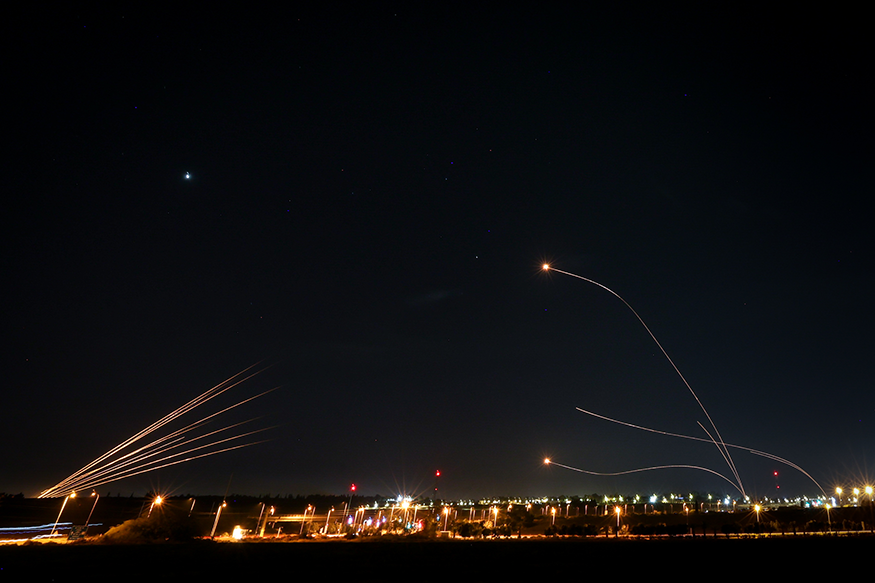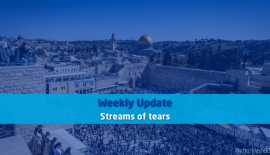Palestinian violence and Iran’s multi-front-war against Israel
Within one week at the beginning of May, Israel and the Palestinian terror groups in Gaza came close to war again twice. The pattern of these recent confrontations differs from what we saw in the past, however, and there is a clear reason for this as we shall see.
Let’s start first with what happened on Tuesday, May 2, when Palestinian terror groups in Gaza fired a total of 104 rockets and mortar shells at southern Israel. Another Gaza war seemed inevitable then after terror groups in the coastal enclave began a new round of rocket fire on southern Israel. The renewal of the rocket attacks on southern Israel happened after it was revealed that a PIJ leader from Jenin who was being held by Israel had died in an Israeli hospital after he went on a hunger strike.
The PIJ leader Khader Adnan had gone on a hunger strike for 86 days before he died. Immediately following the announcement of his death, threats emanated from Gaza. PIJ published a compilation photo on Facebook and Instagram showing missile batteries alongside masked terrorists. “You will burn in our hell,” it read in Arabic and Hebrew below the images, and soon after rockets and mortar shells began to rain down on southern Israel. At least 11 people were injured in those rocket attacks, including three Chinese foreign workers, while many others once again suffered from shock.
Iron Dome
Israel’s media, meanwhile, reported that something big was about to happen after the government in Jerusalem announced a strong response would be forthcoming, and indeed for a short while, it seemed this could be true. I personally observed six Israeli Air Force (IAF) Hercules cargo planes transferring Iron Dome missile defence batteries from the Golan Heights to the border area around Gaza. It was reported that the IDF was deploying additional Iron Dome systems in both the northern part of Israel bordering Lebanon as well as the Gaza belt. PIJ and Hamas fired a total of 104 rockets into southern Israel and Iron Dome shot down 24 of these projectiles, while 25 failed to reach their target. The IAF responded with a total of 16 airstrikes against Hamas and PIJ targets in Gaza, destroying a part of the military infrastructure there. According to Hamas, one civilian was killed and five other civilians were injured, while eyewitnesses reported the IAF planes were shot at with surface-to-air missiles, which was a relatively new development.
“Weak reaction”?
Shortly after midnight on Tuesday, May 2, it was announced that Egypt, along with Qatar and the United Nations, was making a frantic effort to negotiate a ceasefire, and by 4 AM the rocket fire was slowly halted. Then came massive criticism of the Israeli government over its “weak response” with National Security Minister Itamar Ben-Gvir challenging Prime Minister Benjamin Netanyahu to fire him for refusing to take part in Knesset votes. Without Otzma Yehudit, Ben Gvir’s far-right party that holds five seats in the Knesset, the government would fall. However, there was more than meets the eye regarding Israel’s decision to agree to a quick ceasefire.
Before the IAF responded to the rocket fire, the opening of a second front in the border area with Lebanon was taken into account in Jerusalem. When that didn’t happen and PIJ and Hamas apparently deliberately limited themselves to firing short-range missiles, things seemingly changed. Seemingly because on the night of Monday, May 8 on Tuesday, May 9 it became clear that the Israeli response to the rocket fire from Gaza had been only an initial one. Israeli warplanes and suicide drones suddenly carried out a massive attack on the leadership of PIJ and on the military infrastructure of the organization. Four top commanders of the Iranian-backed terror organization were assassinated in their homes by the IAF which used suicide drones and guided precision missiles to eliminate the PIJ top again.
Again, because the same thing happened in August last year when the Israeli air force took out the entire PIJ top in Gaza in an operation that lasted only one hour and decided the outcome of that confrontation. Operation ‘Breaking Dawn’ as that mini-war was dubbed by the Israeli military was the result of months of intelligence gathering during which the phones of the PIJ commanders were eavesdropped on.
Now exactly the same happened as data released by the Israeli military showed. The IAF hit at least five military outposts belonging to PIJ and destroyed a large number of missiles that were ready for use against Israeli civilian targets. The apartments of PIJ commanders Haij Tariq Izz-a-Din and Dr. Jamal Khadaoun in Gaza’s a-Shahdaa street were hit by precision missiles that destroyed only the homes of the PIJ commanders and not the whole building. The same counted for the apartment of another PIJ commander, Khalil al-Bahtini. The IAF used a so-called suicide drone to assassinate a fourth PIJ commander, Jihad al-Ahnam who was the head of the PIJ southern division in Gaza. Among those who were assassinated by the IAF was the PIJ terrorist who planned the murder of Tali Hatuel and her four daughters who were shot to death in their car near the Kissufim crossing in Gaza in May 2004.
Immediately after the beginning of the new Israeli operation, which was dubbed ‘Shield and Arrow’, the IDF Home Front brigade issued guidelines for residents of the so-called Gaza belt and declared the area of the Gaza border a no-go zone. Bomb shelters in the south of Israel were opened and schools were closed while people were allowed to work from home. All these measures were taken in anticipation of a new round of rocket fire after both PIJ and Hamas vowed to take revenge. The revenge came on Wednesday afternoon when PIJ launched massive salvos of rockets on the south and center of Israel. As of the writing of this analysis 350 projectiles were fired with half of them falling in the sea or inside Gaza. Hamas is reportedly staying out of the fray while the IAF launched 40 counter strikes. This could be another indication that the Iranian ‘axis of resistance isn’t interested in a wider confrontation with the Israeli military at the moment.
Multi-front warfare and “Light Shield”
The Israeli army is preparing for this long-anticipated multi-front war with the Iranian Axis during which approximately 1,300 rockets per day are expected to be fired at Israel from three or even four fronts (Yemen). Are the IAF and the IDF ready for such a war? That is also very much the question, and it mainly concerns the amount of missile defence systems and ammunition that will be needed. The Israeli army is impatiently waiting for the introduction of the so-called “Laser Beam” or “Light Dome”.
According to the latest information, the new system produced by Rafael will soon be introduced by the IDF and then it will take some time before the whole of Israel is covered by the Light Shield. Light Dome or Light Shield works with laser beams of 100 kilowatts that can hit a target the size of a coin. The laser beams can also simultaneously shoot multiple targets (any air weapon) out of the air. The use of this system is also much cheaper than Iron Dome or other Israeli anti-missile systems with a single laser shot costing just over $3, while every Iron Dome interceptor costs about $50,000. The Light Shield can also be used against any flying object while the other systems, including David’s Sling and the Patriot, cannot. The introduction of the laser system does not mean that Iron Dome can be scrapped because Light Shield does not work well in bad weather.
The broader picture
Prime Minister Benyamin Netanyahu in particular has his eyes on the larger picture of the looming multi-front war and apparently refuses to let the military in Gaza get bogged down in Gaza again at this point in time. Those who follow what is happening in the wider Middle East will understand this.
As I repeatedly reported earlier, the Israeli Air Force is very active in Syria against the Iranian Axis and has conducted hundreds of airstrikes over the years.
The night before the new confrontation with Hamas and PIJ began on May 2, the IAF again attacked the airport of the northern Syrian city of Aleppo (Chalab) and as usual, it was about preventing Iranian arms shipments to the Quds Force of the Islamic Revolutionary Guard Corps (IRGC) and Hezbollah. The airport was once again temporarily closed after Israeli missiles destroyed a part of the landing strip and killed four Syrian soldiers and three members of an unnamed Shiite militia.
The IDF strike in Aleppo came on the heels of another one the previous day when targets in the vicinity of the Syrian city of Homs were attacked. In Iran itself, during the brief confrontation in Gaza, another mysterious explosion was reported at an IRGC base near the town of Damghan killing two IRGC members. No more information was immediately available, but the Israeli foreign intelligence agency Mossad has almost always been behind such explosions in the past.
At the same time, Syrian opposition media reported that armed fighters belonging to the Iranian-backed Iraqi Hashd al-Sha’abi umbrella organization of predominantly Shiite militias were mobilizing in eastern Syria near the border with Iraq. The establishment of the now massive Iraqi forces was pushed for at the time by the liquidated commander of the Quds Force, Qassem Soleimani. Netanyahu has hinted repeatedly lately that more is happening than meets the eye in the confrontation with Iran and its allies. The Israeli PM said in early May that Israel is operating every day and everywhere to contain the threat from Iran. So, the situation in the Middle East and Israel’s position in it is much more complicated than the conflict with Hamas and PIJ in Gaza alone.
Diplomatic offensives
One can also see from what is happening on the political front that something is brewing regarding Iran’s aggression toward Israel. Iran’s Foreign Minister Hossein Amir-Abdollahian was in Lebanon just before the new confrontation with PIJ and Hamas and toured the border with Israel, threatening that the “Zionists” would only understand force and would soon be further “isolated” and then “destroyed.” Ibrahim Raisi, the President of Iran, was in Syria a couple of days later where he conducted talks with Syrian dictator Bashar al-Assad. It was the first visit by an Iranian president to Syria in 13 years. Israel, in turn, is engaged in a diplomatic offensive against Iran in Europe and is building a new alliance against the Islamic Republic.
Foreign Minister Eli Cohen spoke with EU High Commissioner for Foreign Affairs Josep Borrell about the Iranian issue, and he did the same with the Spanish government at the beginning of May. The Israeli minister is actively building a new diplomatic and military front against Iran and recently also travelled to Azerbaijan and Turkmenistan, two neighbouring countries of Iran.
Situation in Iran
In Iran itself, the regime of Ayatollah Ali Khamenei seems to be sinking further and further into a self-created quagmire. Protests against Khamenei’s government continue, and the leader of the Islamic revolution was recently forced to interrupt a speech after being booed by angry protesters. This was the first time that Khamenei experienced the anger of the Iranian people himself. Living conditions in Iran are now so bad that people are no longer able to buy basic necessities, while rent prices have further increased to such an extent that the population is forced to hold two jobs. Even philanthropists who used to help the poor by paying their bills in grocery shops have been forced to stop doing so, according to Iranian opposition sources.
From the Iranian point of view opening a multi-front confrontation with the Israeli army at this point in time might not be the smartest move. This is not related to the internal unrest in Iran but to the developments in Iran’s nuclear weapons program. According to Israeli defence officials Iran has now accumulated enough highly enriched uranium hexafluoride gas for the production of 5 nuclear warheads.
As Israel’s military is far superior to that of Iran and even to the many Iranian proxies it would be better to launch the long-anticipated multi-front war under a nuclear umbrella according to the Iranian regime’s line of thinking. So, for the time being, Iran uses its Palestinian proxies in both Gaza and Israel’s Biblical heartland for a war of attrition against the Jewish state while Israel tries to uphold a certain level of deterrence against these proxies. It would, of course, be better to root out these proxies completely but the IDF top, as well as the majority of politicians in Israel, are not willing to do this because of fear of the international response. This is despite Netanyahu’s conviction that Iran is responsible for 95 percent of the Palestinian violence against Israel and despite the knowledge that PIJ and Hamas are now working on a missile capacity in Palestinian cities like Jenin and Shechem (Nablus).





